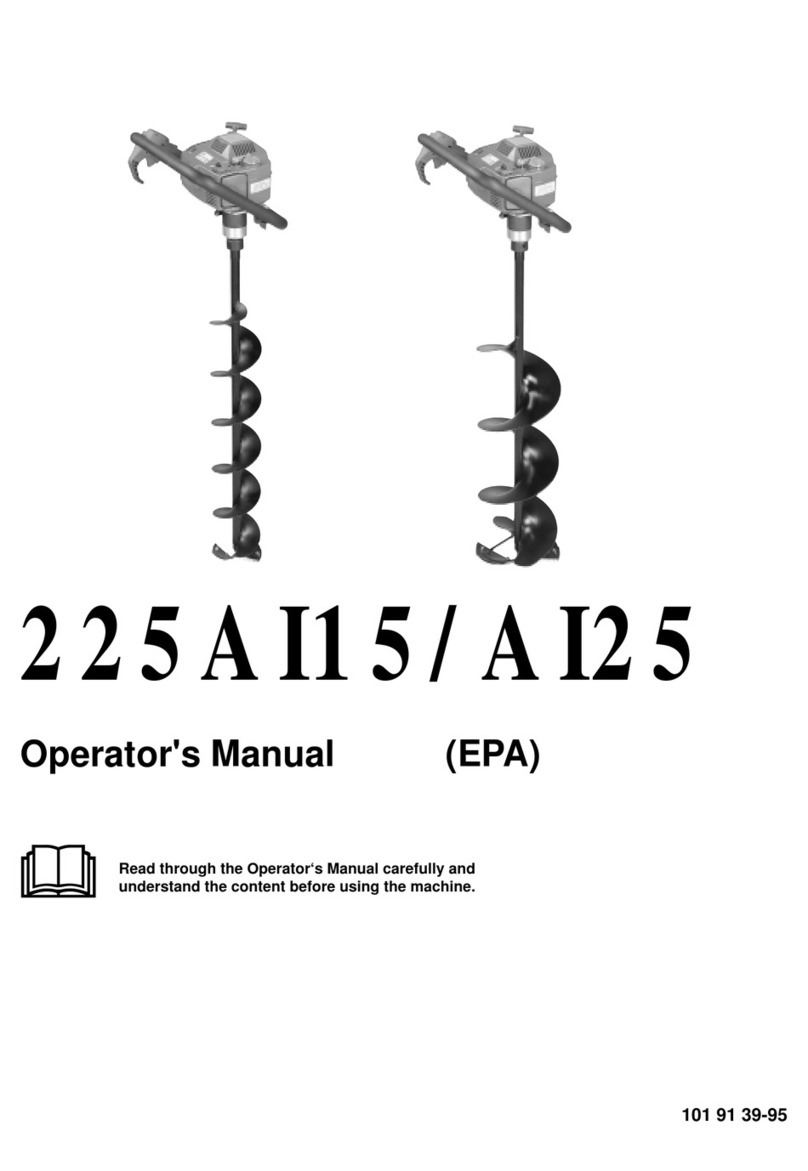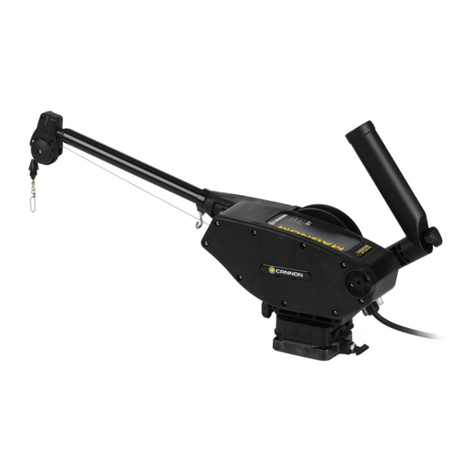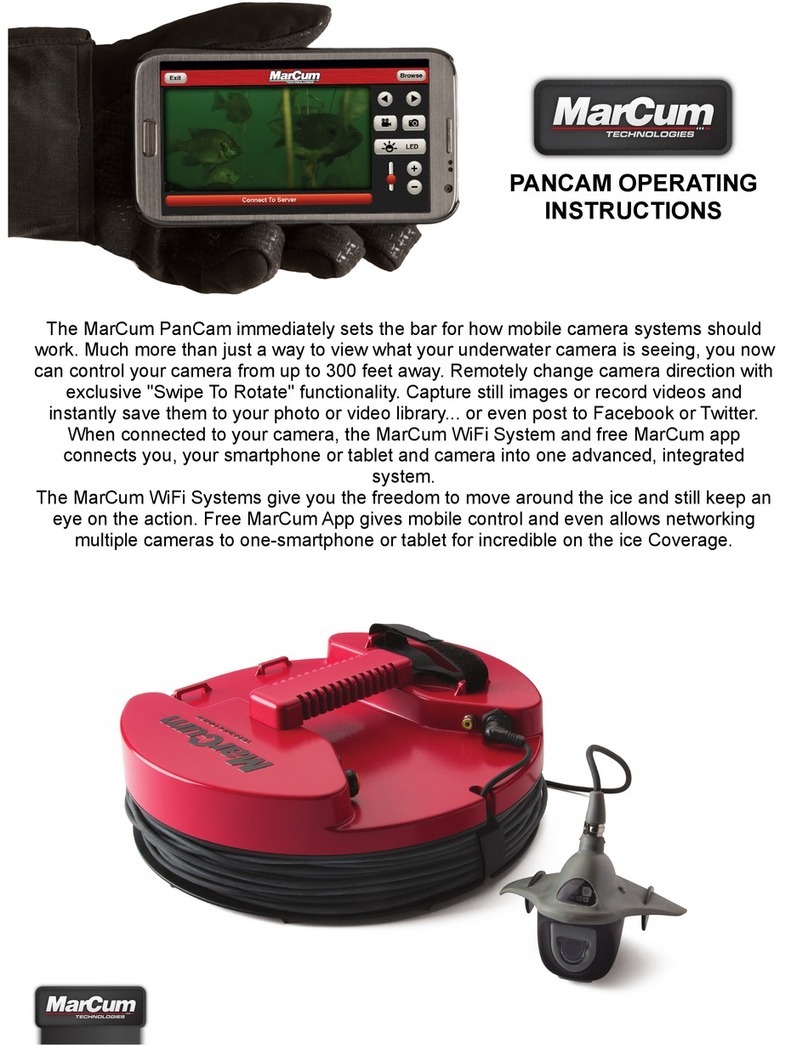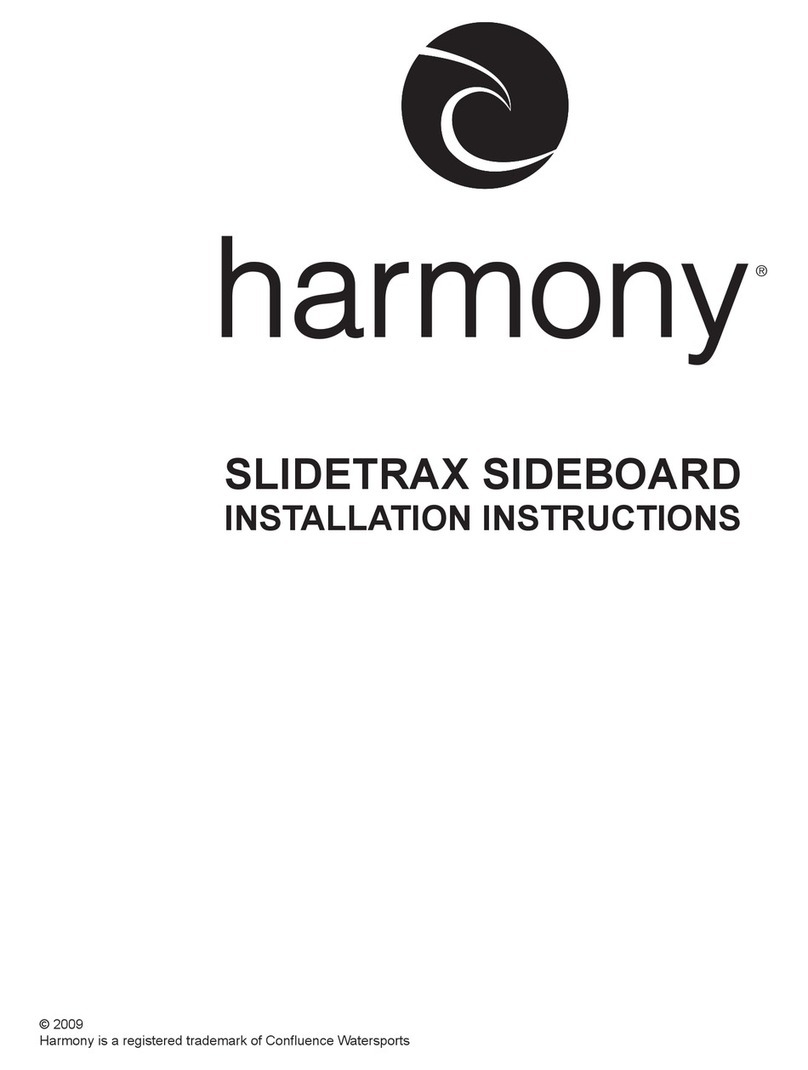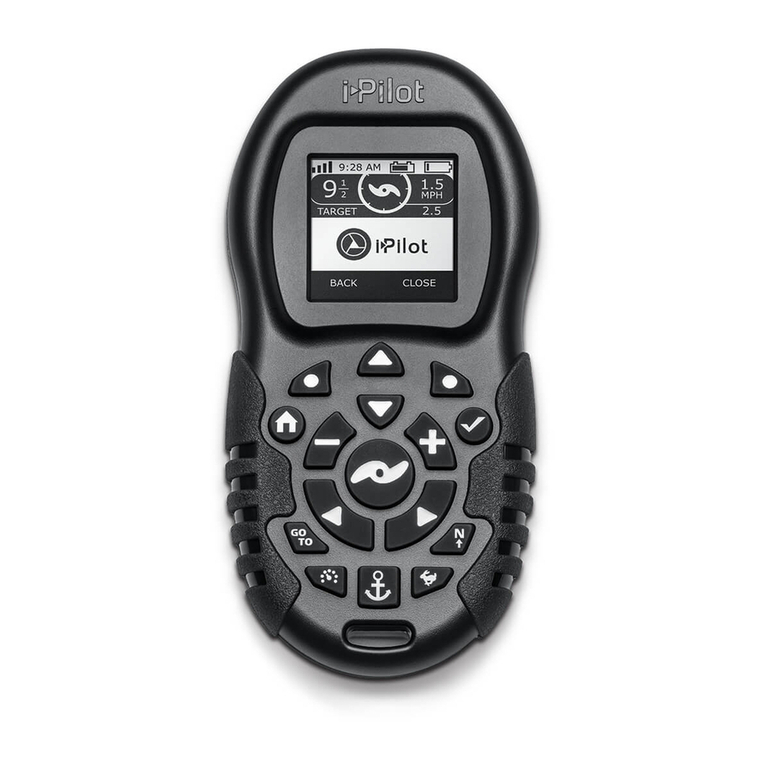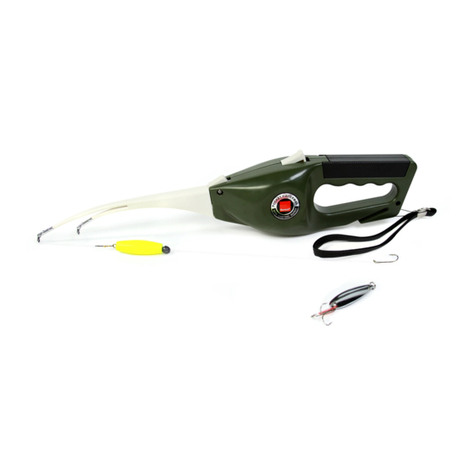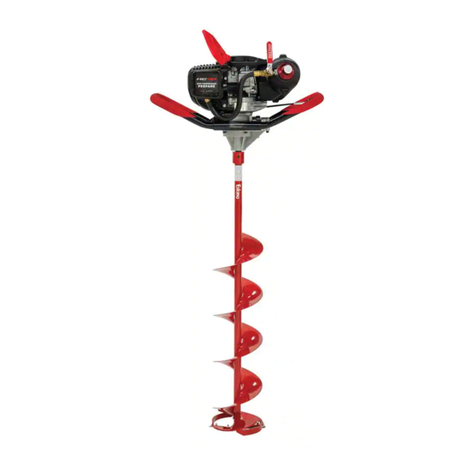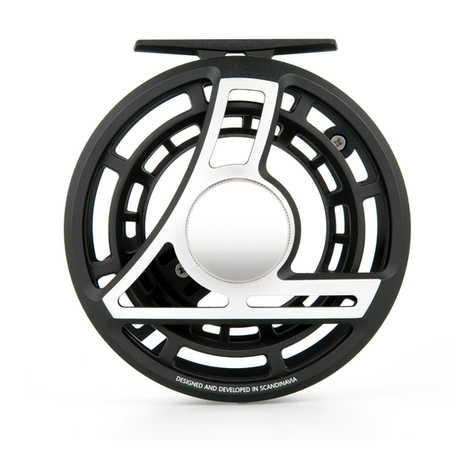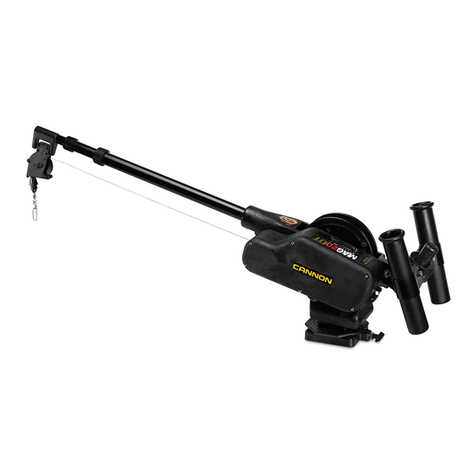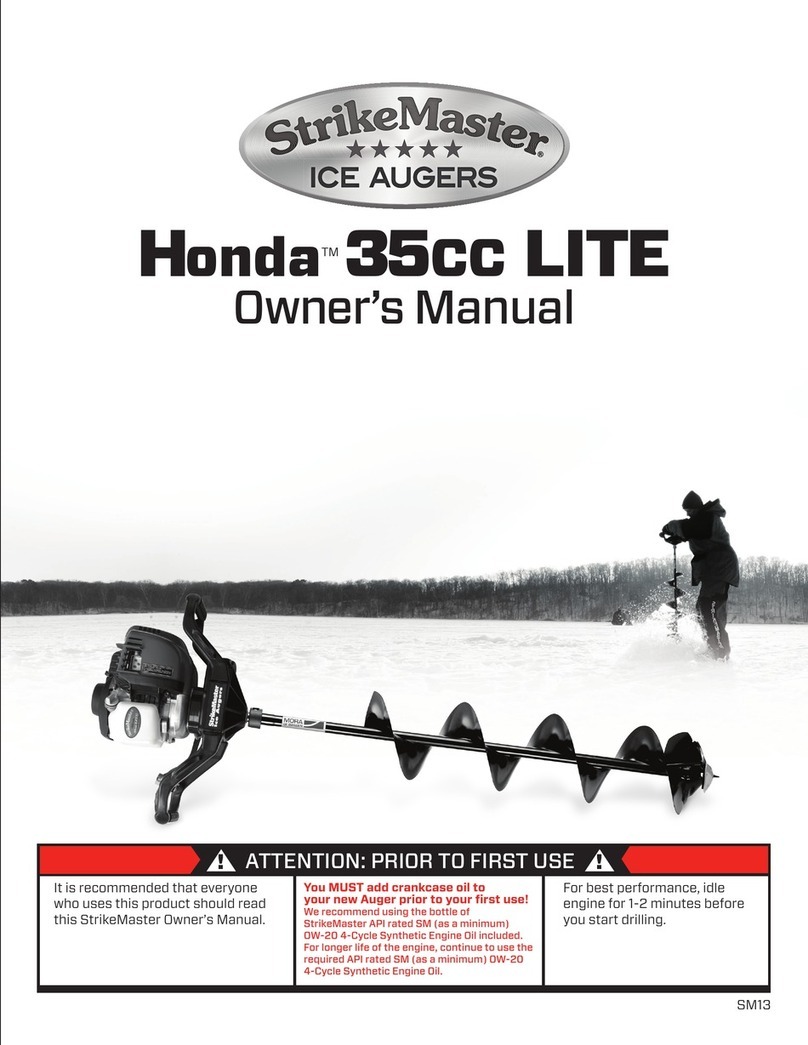Husqvarna 225AI15 User manual

225AI15/AI25
Operator's Manual
Read through the Operator‘s Manual carefully and
understand the content before using the machine.
101 91 39-26

2– English
SYMBOL EXPLANATION
WARNING! This machine can be
dangerous!
Careless or incorrect use can result in
serious, even fatal injury.
Read through the Operator‘s
Manual carefully and understand the
content before using the machine.
Always use
• Ear protection
Symbols
• This product is in accordance with
applicable CE directives.
• Always wear approved protective
gloves.
Checks and/or maintenance should be
carried out with the engine switched off,
with the stop switch in the STOP
position.
Always use approved protective gloves.
Regular cleaning required.
Ocular control.
Other symbols/decals on the machine refer to
special certification requirements for certain
markets.

English –3
CONTENTS
List of contents
SYMBOL EXPLANATION
Symbols ............................................................................... 2
CONTENTS
List of contents .................................................................... 3
SAFETY INSTRUCTIONS
Personal protective equipment ............................................. 4
The machine’s protective equipment .................................... 4
Control, maintenance and service of the machine‘s
safety equipment ............................................................ 5
General safety instructions ................................................... 7
Safety instructions for using the machine ............................. 8
Fitting the auger .................................................................. 9
WHAT IS WHAT?
What is what on the ice auger? ........................................... 10
FUEL HANDLING
Fuel ................................................................................... 11
Fuelling.............................................................................. 11
START AND STOP
Control before starting....................................................... 12
Start and stop..................................................................... 12
MAINTENANCE
Carburettor ........................................................................ 13
Muffler .............................................................................. 14
Cooling system .................................................................. 14
Air filter ............................................................................. 15
Spark plug.......................................................................... 15
Maintenance schedule ........................................................ 15
TECHNICAL DATA
225AI15 ............................................................................ 17
225AI25 ............................................................................ 17
WARNING!
Under no circumstances may the design
of the machine be modified without the
permission of the manufacturer. Always
use genuine accessories. Non-authorised
modifications and/or accessories can
result in serious personal injury or the
death of the operator or others.
!
Husqvarna AB has a policy of continuous product development
and therefore reserves the right to modify the design and
appearance of products without prior notice.

4–English
The machine’s protective equipment
This section describes the machine‘s safety equipment, its
function and how checks and maintenance are carried out to
ensure that it operates correctly. (See the chapter “What is
what“ to locate where this equipment is positioned on your
machine.)
IMPORTANT INFORMATION
•Incorrect or careless use of this machine can turn
it into a dangerous tool that can cause serious or
even fatal injury. It is extremely important that you
read and understand this manual.
•When using the machine you must wear
protective equipment that is approved by the
appropriate authorities. Personal protective
equipment does not eliminate the risk of
accidents, however it can reduce the effects of an
injury in the event of an accident. Ask your dealer
for help when choosing protective equipment.
Personal protective eqipment
GLOVES
Gloves should be worn when
necessary, e.g., when
inspecting, cleaning or
assembling cutting equip-
ment.
EAR PROTECTION
Ear protection offering
sufficient dampening effect
should be used.
BOOTS
Use anti-slip and stable
boots.
FIRST AID KIT
A first aid kit should be close
at hand.
SAFETY INSTRUCTIONS
1. Throttle trigger lock
The throttle trigger lock is
designed to prevent the
throttle from accidentally
being engaged. The trigger
(A) can only be pressed in, if
the lock (B) is held in (= the
operator holding the
handle). When the grip on
the handle is released the
throttle and the throttle
trigger lock return to their
original positions. This
takes place via two indepen-
dent return spring systems.
This means that the throttle
is automatically locked in
the idling position.
2. Stop switch
The stop switch (C) should
be used to stop the engine.
WARNING!
Never use a machine with defective safety
equipment. Follow the control,
maintenance and service instructions
described in this section.
!
"
C
B
A

English –5
SAFETY INSTRUCTIONS
3. Muffler
The muffler is designed to
give the lowest possible
noise level and to direct the
engine’s exhaust fumes away
from the user. A muffler
fitted with a catalytic
converter is also designed to
reduce harmful exhaust
emissions.
It is extremely important
that the instructions for
checking, maintaining and
servicing the muffler are
followed (see the section
“Control, maintenance and
service of the machine’s
safety equipment”).
Control, maintenance and service of
the machine‘s safety equipment
IMPORTANT INFORMATION
•All service and repairs to the machine require
special training.
•This applies especially to the machine‘s safety
equipment. If the machine does not meet any of
he controls listed below you should contact
your service workshop.
•The purchase of one of our products
guarantees that professional repair and
servicing will be carried out on it. If the point of
purchase is not one of our servicing dealers,
please ask for details of the closest service
workshop.
WARNING!
Never use a machine with defective safety
equipment. The safety equipment should
be maintained as described in this
section. If your machine does not meet
any of these controls you should contact
your service workshop.
!
WARNING!
Always stop the engine before doing any
work on the cutting attachment. This will
continue to move even after the throttle
has been released. Ensure that the
cutting attachment has stopped
completely and remove the cable from the
spark plug before you start to work on it.
!
!
WARNING!
Mufflers fitted with catalytic converters
become extremely hot during use and
after stopping. This also applies at idling
speeds. Contact can result in burns to
the skin. Be observant to the risk of fire!
!
WARNING!
Bear in mind that exhaust fumes:
•contain carbon monoxide, which can
cause carbon monoxide poisoning.
Therefore never start or run the machine
indoors.
•are hot and can contain sparks that can
cause fires. Never start the machine
indoors or close to inflammable material.
4. Transport guard
The transport guard (A) is
intended to protect against
any part of the body coming
into contact with the cutting
edges (B).
The transport guard must
always be fitted over the
cutting attachment when
the machine is transported
or stored.
B
A

6–English
SAFETY INSTRUCTIONS
1. Throttle trigger lock
•Check that the throttle is
locked in the “idling
position“when the
throttle trigger lock is in
its original position.
•Press in the throttle
trigger lock and make
sure it returns to its
original position when
released.
•Ensure that the throttle
and throttle trigger lock
move easily and that their
return spring systems
function.
•See the section ”Start”.
Start the machine and
apply full throttle.
Release the throttle and
check that the cutting
attachment stops and
remains stationary. If the
cutting attachment
continues to move when
the throttle is in the idle
position then the
carburettor idle setting
must be adjusted.
See the chapter
“Maintenance”.
2. Stop switch
•Start the engine and
make sure that the engine
stops when the stop
switch is moved to the
stop position.
3. Muffler
•Never use a machine that
has a defective muffler.
•Check regularly that the
muffler is secure.
•If your muffler is fitted
with a spark arrest screen
then it should be cleaned
regularly. A blocked
screen leads to the engine
overheating with serious
damage as a result. Never
use a muffler with a
defective spark arrest
screen.
5. Transport guard
•Regularly check that the
transport guard is not
damaged.
•Replace the transport
guard if it is damaged.
4. Cutters
•Ensure that the cutters
are securely attached.
•When the blade is
manufactured it is
sharpened using an
advanced method. This
means that the blade
cannot be re-sharpened
using conventional
methods. Worn blades
must be replaced with
new ones to ensure your
machine works
satisfactorily.

English –7
IMPORTANT INFORMATION
•The machine is solely designed for drilling in
ice.
•Never use the machine if you are tired, if you
have consumed alcohol, or if you are taking
medicines that can affect your sight, your
judgement or the control of your body.
•Use personal protective equipment. See the
section
”Personal protective equipment”.
•Never use a machine that has been modified so
that it no longer corresponds with the original
design.
•Never use a machine that is faulty. Follow the
maintenance, control and service instructions in
this Operator’s Manual.
Some maintenance and service actions should
be carried out by trained and qualified
specialists. See the chapter
”Maintenance”
.
Fuel safety
•Never fill the machine while the engine is running. Always
stop the engine and let it cool for a few minutes before
refuelling.
•Provide good ventilation when filling or mixing fuel (petrol
and 2-stroke oil).
•Move the machine at least 3 m from the filling position
before starting.
•Never start the machine:
a) If you have spilt fuel on it. Wipe up all spillage.
b) If you have spilt fuel on yourself or your clothes. Change
your clothes.
c) If there is a fuel leak. Make regular checks for leakage from
the fuel cap and the fuel supply pipes.
SAFETY INSTRUCTIONS
General safety instructions
•The gearbox and clutch drum must be fitted before the
machine is started, otherwise the clutch can become loose
and cause personal injury.
•Never start the machine indoors. Bear in mind the dangers
of inhaling the engine’s exhaust fumes.
•Check your surroundings and make sure that there is no
risk of people or animals coming into contact with the
cutting attachment.
•Place the machine on the
ice. Press the body of the
machine against the ice
using your left hand
(NOTE! Do not use your
foot). Grip the starter
handle with your right
hand and pull the starter
cord.
Start Transport and storage
•Store and transport the machine and fuel so that any
leakage or fumes do not risk coming into contact with
sparks or naked flames. For example, electric machines,
electric motors, electrical switches/power switches, heaters
or the like.
•When storing and transporting fuel, approved containers
intended for this purpose must be used.
•When storing the machine for long periods the fuel tank
must be emptied. Contact your local petrol station to find
out how to dispose of excess fuel.
•The transport guard for the cutting attachment must always
be fitted when the machine is transported or stored.
WARNING!
Exercise great care when handling fuel.
Bear in mind the risk of fire, explosions
and inhaling fumes.
!

8–English
SAFETY INSTRUCTIONS
Safety instructions for using the
machine. Protective instructions while working
•Always ensure you have a
safe and firm working
position.
•Always use both hands to
hold the machine.
•Make sure that no part of
your body comes into
contact with the cutting
attachment when the
engine is running.
•When the engine is
switched off make sure
that no part of your body
comes into contact with
the cutting attachment
before the cutting
attachment has come to a
complete stop.
•If vibration occurs you must stop the machine. Remove the
spark plug cable from the spark plug. Check that the
machine is not damaged. Repair any damage.
Personal protection
•Always use the safety
equipment described in the
section “Personal
protective equipment”.
•Never wear loose-fitting
clothes, scarves, jewellery
or similar items that could
get caught in the auger.
•Hair should be put up if
longer than shoulder
length.
!WARNING!
The machine can cause serious personal
injury. Read the safety instructions
carefully. Learn how to use the machine.
!WARNING!
Cutting tool. Do not touch the cutting
attachment without first switching off the
engine
NOTE! Read the safety instructions carefully before starting to
use the machine.
•Never allow children to use the machine.
•Ensure no-one comes within 5 metres while working.
•Never allow anyone to use the machine without first being
absolutely sure that they understand the contents of the
Operator’s Manual.
•To prevent damage to the blades, make sure you do not use
the auger in areas where the blades could come into contact
with gravel or stones, especially in shallow water or
underneath bridges, etc.
Protective instructions regarding the
surroundings !WARNING!
Over exposure to vibrations can result in
blood-vessel or nerve injury to persons
suffering with blood circulation problems.
Seek medical attention if you experience
physical symptoms that can be related to
over exposure to vibrations. Examples of
such symptoms are ”numbness”, lack of
feeling, ”tickling”, ”pricking”, ”pain”, lack
of or a reduction in normal strength,
changes in the colour of the skin or its
surfaces. These symptoms normally appear
in the fingers, hands or wrists.

English –9
Protective instructions when
work is completed
•The transport guard must always be fitted to the cutting
attachment when the machine is not in use.
•Ensure the cutting attachment has stopped and remove the
spark plug cable from the spark plug before carrying out
cleaning, repairs or inspection.
•Always wear heavy gloves
when replacing the
cutters. The cutters are
extremely sharp and can
easily cause cuts.
•Store the machine out of
reach from children.
•Only use original spare
parts when carrying out
repairs.
SAFETY INSTRUCTIONS
Basic working techniques
•Make sure you have a
safe and steady working
position.
•Always use both hands to
hold the machine.
•Place the tip of the drill
on the ice.
•Open the throttle
gradually when the drill
begins to bite into the
ice.
•Keep a firm grip on the
handles and be ready to
take the weight when the
drill tip goes through the
ice.
•When you have finished
drilling for the time
being, drill a short
distance into the ice so
that the machine stands
up by itself. By leaving
the machine like this you
reduce the risk of anyone
accidentally coming into
contact with the cutters.
•Always turn off the
engine when you have
finished drilling.
Fitting the auger
•Fit the auger (A) to the
output shaft (B).
•Fit the screws (C) and
tighten using the Allen key
provided.
A
B
C

10–English
12. Choke
13. Allen key
14. Spark plug spanner
15. Blade cover (Transport)
16. Air purge
17. Drill
18. Cutter
19. Cutting attachment
WHAT IS WHAT?
What is what on the ice drill?
1. Operator’s Manual
2. Gearbox
3. Loop handle
4. Cylinder cover
5. Starter handle
6. Stop switch
7. Throttle trigger lock
8. Throttle trigger
9. Fuel tank
10. Fuel cap
11. Air filter cover
15 7
13 14
1
8
6
12
2
16 5
9
11 10
4
18
17
19
13
3

English –11
FUEL HANDLING
•Clean around the fuel cap. Contamination in the tank can
disrupt operations.
•Ensure that the fuel is well mixed by shaking the container
before filling the tank.
Petrol
NOTE!
Always use an oil-mixed
quality petrol (at least 90
octane). If your machine is
equipped with a catalytic
converter, (see “technical
data”) an unleaded, oil
mixed quality petrol should
always be used. A leaded
petrol will destroy the
catalytic converter.
•The lowest recommended
octane rating is 90. If you
run the engine on a petrol
with a lower octane rating
than 90 so-called
“knocking“can occur.
This leads to an increased
engine temperature,
which can result in a
serious engine
breakdown.
•When working at
continuous high revs a
higher octane rating is
recommended.
WARNING!
Always provide good ventilation when
handling fuel.
!
!
Fuelling
WARNING!
The following precautions reduce the risk
of fire:
Do not smoke or place any sources of heat
in the vicinity of the fuel. Never refuel
when the engine is running. Always stop
the engine and let it cool for a few minutes
before refuelling. Open the fuel cap slowly
when fuelling so that any over pressure is
released slowly. Tighten the fuel cap
carefully after refuelling. Always move the
machine from the fuelling place before
starting.
!WARNING!
The catalytic converter muffler gets very hot
during and after use. This also applies
during idling. Be aware of the fire hazard,
especially when handling the saw near
flammable substances or vapours.
Mixture
•Always mix petrol and oil in a clean container intended for
petrol.
•Always start by filling half the quantity of petrol required.
Then add the entire oil quantity. Mix (shake) the fuel
mixture. Fill the remaining quantity of petrol.
•Mix (shake) the fuel mixture carefully before filling in the
machine‘s fuel tank.
•Do not mix more than max. one month’s supply of fuel.
•If the machine is not used for a long period of time, the fuel
tank should be emptied and cleaned.
NOTE!
The machine is fitted with a two-stroke engine and must
always be run on a mixture of petrol and two-stroke oil. It is
important to measure the quantity of oil accurately, to ensure
the correct mixture ratio. Small discrepancies in the amount of
oil have a great bearing on the proportions of the fuel mixture
when mixing small amounts of fuel.
Fuel
Two-stroke oil
•For the best results use
HUSQVARNA two-
stroke oil, which has been
specially produced for
HUSQVARNA’s small,
two-stroke engines.
Mixing ratio 1:50 (2%).
•If HUSQVARNA two-stroke oil is not available you can
use a high quality two-stroke oil intended for air cooled
engines. Contact your dealer when selecting an oil.
Mixing ratio: 1:33 (3%).
•Never use two-stroke oil intended for water cooled out-
board motors, so-called outboard motor oil.
•Never use oil intended for four-stroke engines.
5
10
15
20
2% (1:50)
0,10
0,20
0,30
0,40
3% (1:33)
0,15
0,30
0,45
0,60
Gasolin
Benzin
Essence
Gasolina
Lit.
Oil •Öl
Huile •Aceite
Lit.
1
2 1/2
5
2% (1:50)
2 1/2
6 1/2
12 7/8
3% (1:33)
3 3/4
9 3/4
19 1/4
US
gallon US
fl. oz.

12–English
START AND STOP
Control before starting
•Check the cutters. Never
use cutters that are blunt,
cracked or damaged.
•Check that the machine
is in full working order.
Check that all nuts and
bolts are tightened
correctly.
•Check that the cutting attachment always stops when the
engine is idling.
•Only use the machine for what it is intended for.
•Ensure that the handle and safety functions are in order.
Never use a machine that lacks a part or has been modified
outside of the specifications.
Stop
The engine is stopped by
switching the ignition off
using the stop switch.
Warm engine
IGNITION:
Set the stop switch to the
start position.
CHOKE:
Set the choke control in the
choke position and then
back again to its original
position (B)
In this way only the start
throttle is applied with no
choke.
AIR PURGE:
Press the air purge dia-
phragm repeatedly until fuel
begins to fill the diaphragm.
The diaphragm need not be
completely filled.
Press the machine body
against the ground using your
left hand (NOTE! Not your
foot). Grip the starter handle,
slowly pull out the cord with
your right hand until you feel
some resistance (the starter
pawls grip), now quickly and
powerfully pull the cord.
Reset the choke control as
soon as the engine fires and
repeat until the engine starts.
When the engine starts
quickly apply full throttle and
the start throttle will auto-
matically disengage.
NOTE! Do not pull the
starter cord out completely
and do not release the starter
cord from the fully extended
position. This can damage the
machine.
Start
!
Start and stop
WARNING!
The gearbox and clutch drum must be
fitted before the machine is started,
otherwise the clutch can come loose and
cause personal injury.
Always move the machine about 3 metres
from the filling position before starting.
Place the machine on a firm surface. Make
sure the cutting attachment cannot come
into contact with any object. Make sure
that no unauthorised persons are in the
working area, otherwise there is a risk of
serious personal injury.
B
"
Cold engine
IGNITION:
Set the stop switch to the
start position.
CHOKE:
Set the choke control in the
choke position (A).
The choke position is also
the automatic start throttle
position.
NOTE! If the outside
temperature is very low and
the machine has not been
used in the last hour, let the
engine warm up on start
throttle setting for one
minute.
AIR PURGE:
Press the air purge dia-
phragm repeatedly until fuel
begins to fill the diaphragm.
The diaphragm need not be
completely filled.
A

English –13
Carburettor
Your Husqvarna product has been designed and manufac-
tured to specifications that reduce harmful emissions.
After your unit has been run 8-10 tanks of fuel the engine
has broken in. To ensure that your unit is at peak perform-
ance and producing the least amount of harmful emissions
after break in, have your authorized servicing dealer, who has
a revolution counter at his disposal, to adjust your carburet-
tor for optimum operating conditions.
Basic setting
•The carburettor is set to its basic setting when test run at
the factory. The basic setting is richer than the optimal
setting and should be kept during the machine’s first
working hours. Thereafter the carburettor should be finely
adjusted. Fine adjustment should be carried out by a skilled
technician.
NOTE! If the cutting attachment rotates/moves while the
engine is idling the T-screw should be turned anti-clockwise
until the cutting attachment stops.
Recommended idling speed is: 2 700 rpm.
Recommended max. speed: See “Technical data”.
WARNING!
If the idling speed cannot be adjusted so
that the cutting attachment stops,
contact your service workshop. Do not
use the machine until it has been
correctly adjusted or repaired.
!
MAINTENANCE
Operation
•The carburettor governs
the engine’s speed via the
throttle. Air/fuel is mixed
in the carburettor. The
air/fuel mixture is
adjustable. To take
advantage of the engine’s
optimal output the
adjustment must be
correct.
•The setting of the
carburettor means that
the engine is adapted to
local conditions, for
example, the climate,
altitude, petrol and the
type of 2-stroke oil.
•The carburettor is equipped with three adjustment possi-
bilities:
H = High speed needle
L = Low speed needle
T = Idle speed adjuster screw
•The fuel quantity in relation to the air flow permitted by
the throttle opening is adjusted using the L and H-needles.
Turning the needles clockwise gives a leaner fuel mixture
(less fuel) and turning them anti-clockwise gives a richer
fuel mixture (more fuel). A leaner mixture gives high revs
while a richer mixture give less revs.
•The T-screw regulates the position of the throttle while the
engine is idling. Turning the screw clockwise gives a higher
idling speed while turning it anti-clockwise gives a lower
idling speed.
WARNING!
The complete clutch cover and gearbox
must be fitted before the machine is
started, otherwise the clutch may come
loose and cause personal injury.
!
Adjusting the idle speed, T
Adjust the idle speed with
screw T, if it is necessary to
readjust. First turn the idle
speed adjusting screw T
clockwise until the cutting
attachment begins to move.
Then turn the screw
anticlockwise until the
cutting attachment stops.
The idle speed is correctly
adjusted when the engine
runs smoothly in any
position. There should also
be a good margin to the
engine speed at which the
cutting attachment begins
to move.
CAUTION! Contact your servicing dealer, if the idle speed
setting cannot be adjusted so that the cutting attachment
stops. Do not use the machine until it has been properly
adjusted or repaired.
Correctly adjusted carburettor
A correctly adjusted carburettor means that the machine
accelerates without hesitation and the machine 4-cycles a little
at max. speed. Furthermore, the cutting attachment must not
move at idling. If the setting of the low speed needle L is too
lean it may cause starting difficulties and poor acceleration. If
the setting of the high speed needle H is too lean it causes
lower power = less capacity, poor acceleration and/or damage
to the engine.
An excessively rich adjustment of the two speed needles L and
H gives acceleration problems or too low working speed.
HLT
T

14–English
Cooling system
To maintain as low operat-
ing temperature as possible
the engine is equipped with
a cooling system.
The cooling system consists
of:
1. An air intake on the
starter unit.
2. Cooling fins on the
flywheel.
3. Cooling fins on the
cylinder
4. Cylinder cover (leads
cold air onto the
cylinder).
Clean the cooling system
using a brush at least once a
week, in difficult conditions
more often.
A dirty or blocked cooling
system leads to the engine
overheating resulting in
damage to the cylinder and
piston.
1
4
2
3
MAINTENANCE
Muffler
NOTE!
Some mufflers are fitted with catalytic converters. See “Techni-
cal data”to find out if your machine is equipped with a
catalytic converter.
The muffler is designed to
dampen the noise level and
to direct the exhaust fumes
away from the user. The
exhaust fumes are hot and
can contain sparks, which
can result in fire if the
exhaust fumes are directed
towards a dry and inflam-
mable material. Some
mufflers are equipped with a
special spark arrest screen. If
your machine is fitted with
this type of screen it should
be cleaned regularly. This is
done using a wire brush. On
mufflers without a catalytic
converter the screen should
be cleaned weekly, or
replaced if necessary. On
mufflers fitted with a
catalytic converter the
screen should be checked
and cleaned monthly. If the
screen is damaged it should
be replaced. If the screen is
frequently blocked, this can
be a sign that the function
of the catalytic converter is
impaired. Contact your
dealer to inspect the muffler.
A blocked screen will cause
the engine to overheat
resulting in damage to the
cylinder and piston. Also see
under “Maintenance”.
NOTE!
Never use a machine with a
defective muffler.
!WARNING!
Mufflers fitted with catalytic converters
become extremely hot during use and
after stopping. This also applies at idling
speeds. Contact can result in burns to
the skin. Be observant to the risk of fire!

English –15
Air filter
The air filter (A) should be
cleaned regularly removing
dust and dirt to avoid:
•carburettor malfunction
•starting problems
•reduced engine power
•unnecessary wear to
engine parts
•abnormal fuel consump-
tion
Clean the filter after every
25 hours or more regularly
if operating conditions are
exceptionally dusty.
Cleaning the air filter
Dismantle the air filter cover (B) and remove the air filter.
Wash in clean, warm soapy water. Ensure that the filter is dry
before refitting.
An air filter used for a long period of time can never be cleaned
completely. Therefore it is necessary to replace the filter from
time to time with a new filter. A damaged air filter must always
be replaced.
0,5 mm
MAINTENANCE
Maintenance schedule
Below follows some general maintenance instructions.
If you need further information please contact your service
workshop.
3
1
5
Daily maintenance
1. Clean the outside of the
machine.
2. Make sure the throttle
trigger lock and the
throttle function
correctly from a safety
point of view.
3. Check that the stop
switch functions.
4. Check that the cutting
attachment does not
move when the engine is
idling.
5. Clean the air filter.
Replace if necessary.
6. Check that the transport
guard is not damaged.
Replace the guard if it is
damaged.
7. Check that all nuts and
screws are tightened.
7
A
A
BA
6
4
2
Spark plug
The condition of the spark plug is affected by:
•An incorrect carburettor setting.
•An incorrect fuel mixture (too much or faulty oil).
•A dirty air filter.
These factors cause deposits on the spark plug electrode that
may result in malfunction or starting difficulties.
If the machine is low on
power, difficult to start or
runs poorly while idling
always check the spark plug
first before taking other
action.
The spark plug is accessed
from under the cylinder
cover, which is removed by
loosening the four bolts (A).
If the spark plug is dirty,
clean it and at the same time
check that the electrode gap
is 0.5 mm. The spark plug
should be changed after
about one month of
operation or earlier if
necessary.
NOTE! Always use the
recommended type of spark
plug. An incorrect spark
plug can damage the
cylinder/piston.

16–English
MAINTENANCE
Weekly maintenance
1
5
3
4
1. Check the starter, the
starter cord and the
return spring.
2. Clean the outside of the
spark plug. Remove and
check the electrode gap.
Adjust the gap to 0.5
mm or change the spark
plug.
3. Clean the cooling fins
on the flywheel.
4. Clean or replace the
muffler’s spark arrest
screen (not on mufflers
with a catalytic con-
verter).
5. Clean the carburettor
area.
6. Clean the cooling fins
on the cylinder and
check that the air intake
in the starter unit is not
blocked. 6
2
Monthly
maintenance
4
7
6
2
3
5
1
8
1. Clean the fuel tank.
2. Clean the carburettor and
the area surrounding it.
3. Clean the fan wheel and
the area around it.
4. Check the fuel filter and
the fuel pipe, replace if
necessary.
5. Check all cables and
connections.
6. Check the clutch, clutch
springs and the clutch
drum with regard to
wear. Replace if necessary.
7. Change the spark plug.
8. Check and clean the
muffler’s spark arrest
screen if necessary (only
mufflers with a catalytic
converter).

English –17
225AI15
1,64/26,9
1,38/35
1,10/28
2 700
11 200-12 000
0,9 kW/ 9 000 rpm
Yes
Yes
Walbro MB/CD
Champion RCJ 7Y
0,5
Walbro WT
0,85/0,4
11,7/5,3
100
102
5,8/5,6
7,4/6,0
Type
∅130 mm
∅150 mm
∅200 mm
∅250 mm
Length 275 mm
225AI25
1,64/26,9
1,38/35
1,10/28
2 700
11 200-12 000
0,9 kW/ 9 000 rpm
Yes
Yes
Walbro MB/CD
Champion RCJ 7Y
0,5
Walbro WT
0,85/0,4
12,8/5,8
100
102
5,8/5,6
7,4/6,0
Recommended for
225ΑΙ15
225ΑΙ15
225ΑΙ25
225ΑΙ25
225ΑΙ15/225ΑΙ25
Technical data
Engine
Cylinder capacity, cu. inch/cm3
Cylinder bore, inch/mm
Stroke length, inch/mm
Idling speed, rpm
Recommended max. speed, rpm
Max. engine output, acc. to ISO 8893
Catalytic converter muffler
Speed-regulated ignition system
Ignition system
Manufacturer/type of ignition system
Spark plug
Electrod gap, mm
Fuel lubrication system
Manufacturer/type of carburettor
Fuel tank capacity, US pint/litres
Weight
Weight, without fuel and cutting tool, Lbs/kg
Noise levels
Equivalent noise pressure levels at
the user’s ear , measured acc. to EN 11806
and ISO 7917, dB(A):
Equivalent noise power levels measured acc. to
EN 11806 and ISO 10884, dB(A):
Vibration levels
Vibration levels on the handles measured
according to EN 11806 and ISO 7916, m/s2
Idling, left/right handle:
Max. speed, left/right handle:
Approved cutting attachment
Drill
Drill
Drill
Drill
Extension (Rallonge)
TECHNICAL DATA

18– English
EU declaration of conformity (Only applies to Europe)
(Directive 89/392/EEC, Annex II, A)
We, Husqvarna AB, S-561 82 Huskvarna, Sweden, tel: +46 36-146500, declare under sole responsibility that the ice
augers Husqvarna 225AI15 and 225AI25 from 1998’s serial numbers and onwards (the year is clearly stated in plain
text on the type plate with subsequent serial number), are in conformity with the following standards or other
normative documents following the provisions in the COUNCIL’S DIRECTIVES:
- of June 14 1989 “relating to machinery” 89/392/EEC and applicable supplements.
- of May 3 1989 “relating to electromagnetic compatibility” 89/336/EEC, and applicable supplements.
The following standards have been applied: EN292-2.
SMP Svensk Maskinprovning AB, Fyrisborgsgatan 3 S-754 50 Uppsala, Sweden, has carried out voluntary type
approval for Husqvarna AB. The certificates are numbered: SEC/98/618 – 225AI15/ 225AI25.
Huskvarna August 20, 1998
Bo Andréasson, Development manager.
´*3-|¶6[¨

English –19

2000W43
´*3-|¶6[¨
This manual suits for next models
1
Table of contents
Other Husqvarna Fishing Equipment manuals
Popular Fishing Equipment manuals by other brands
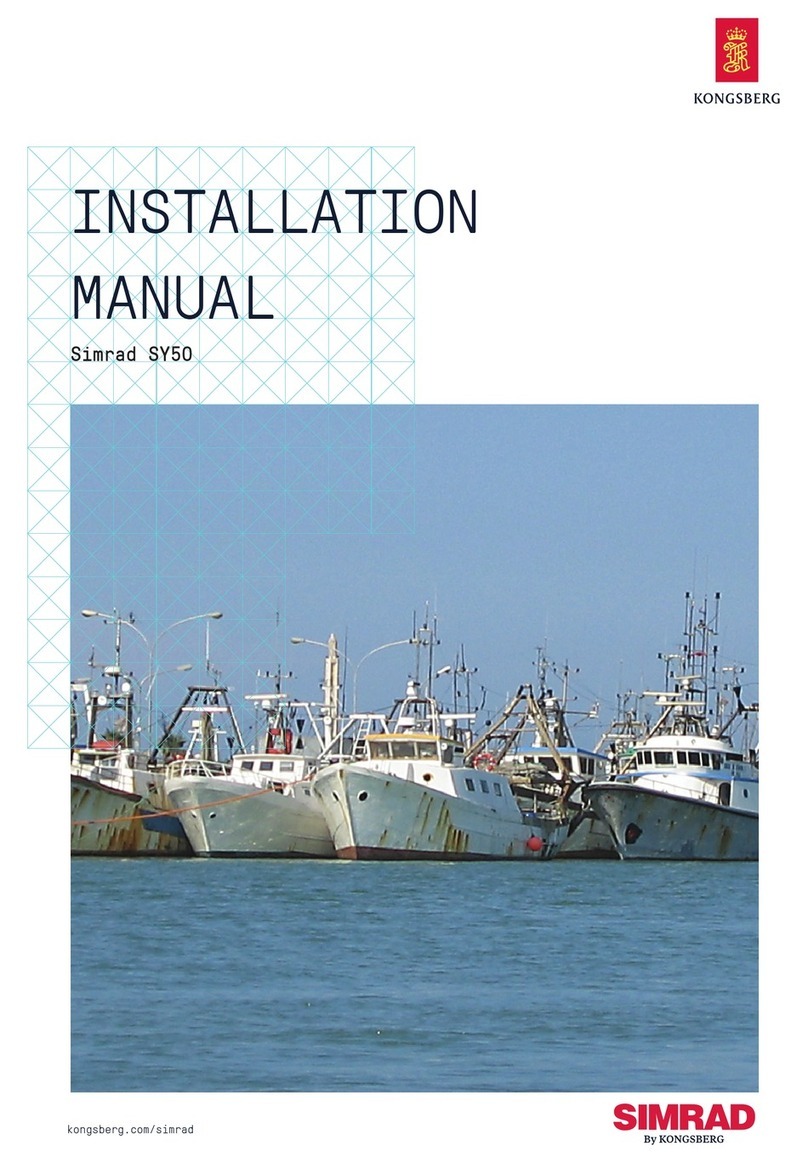
Kongsberg
Kongsberg Simrad SY50 installation manual
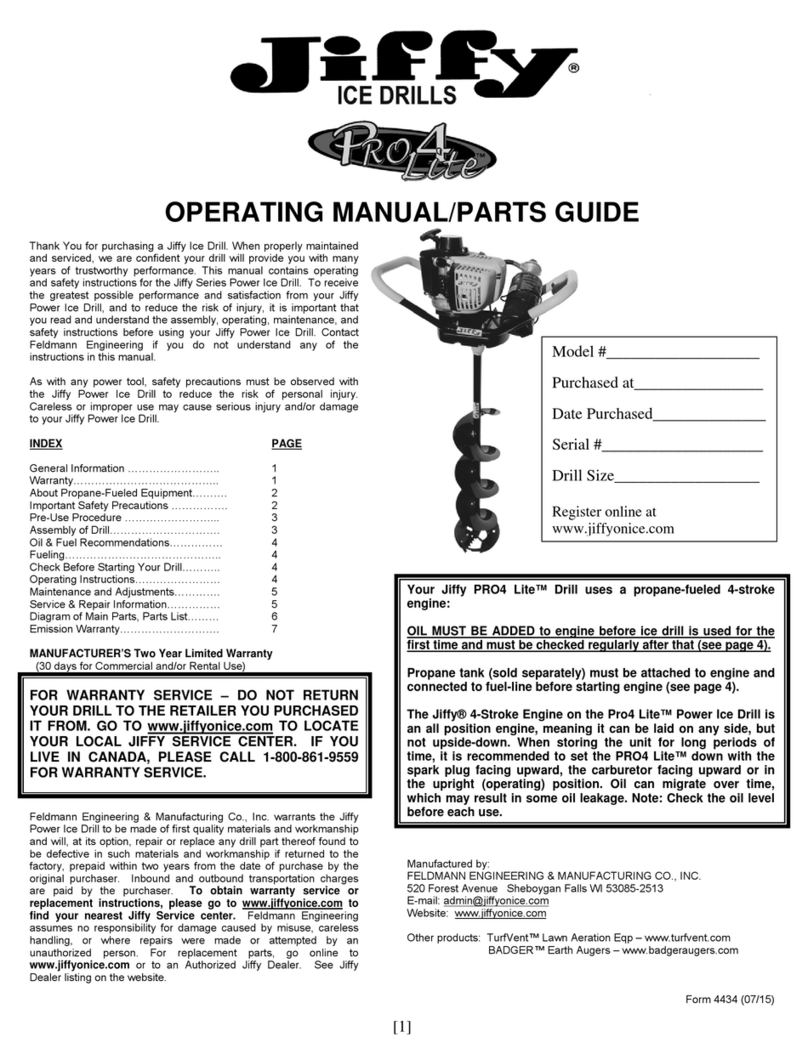
Jiffy
Jiffy Pro4 Lite Operating manual/parts guide

Fishmaster
Fishmaster Pro Series Installation instructions and owner's manual
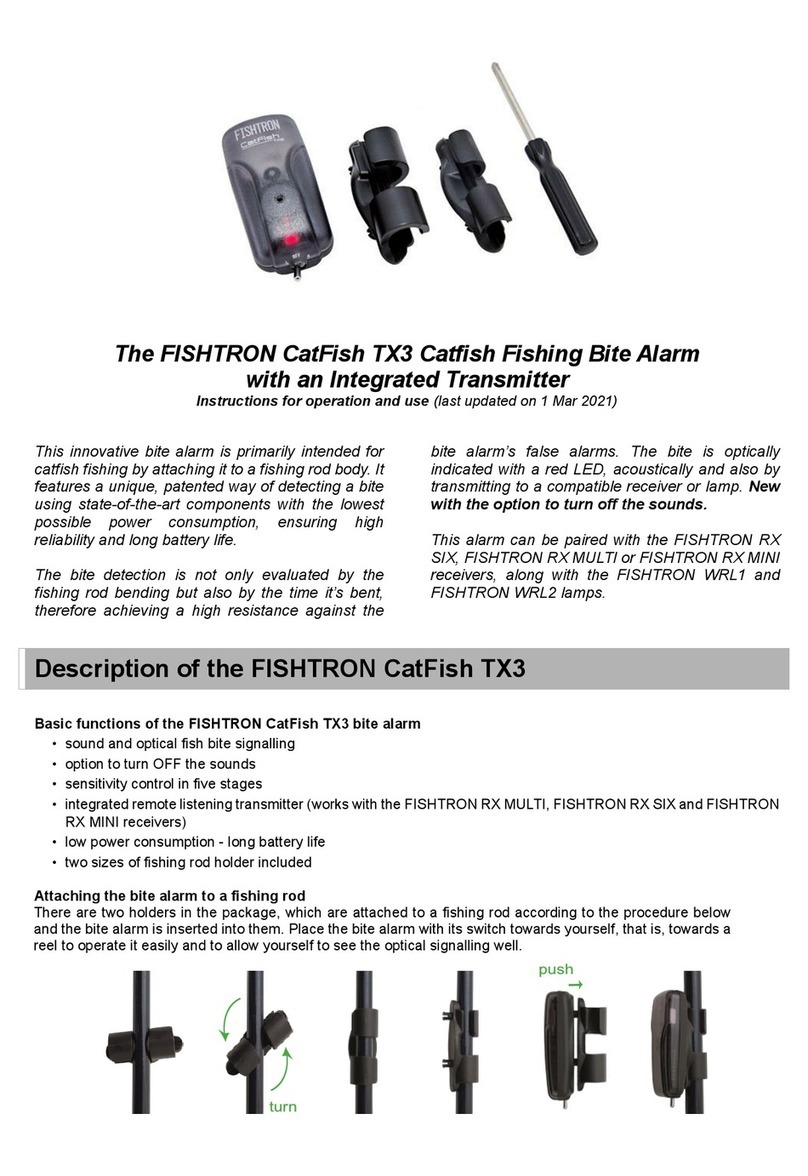
FLAJZAR
FLAJZAR FISHTRON CatFish TX3 Instructions for operation and use

Milwaukee
Milwaukee 2873-20 Operator's manual
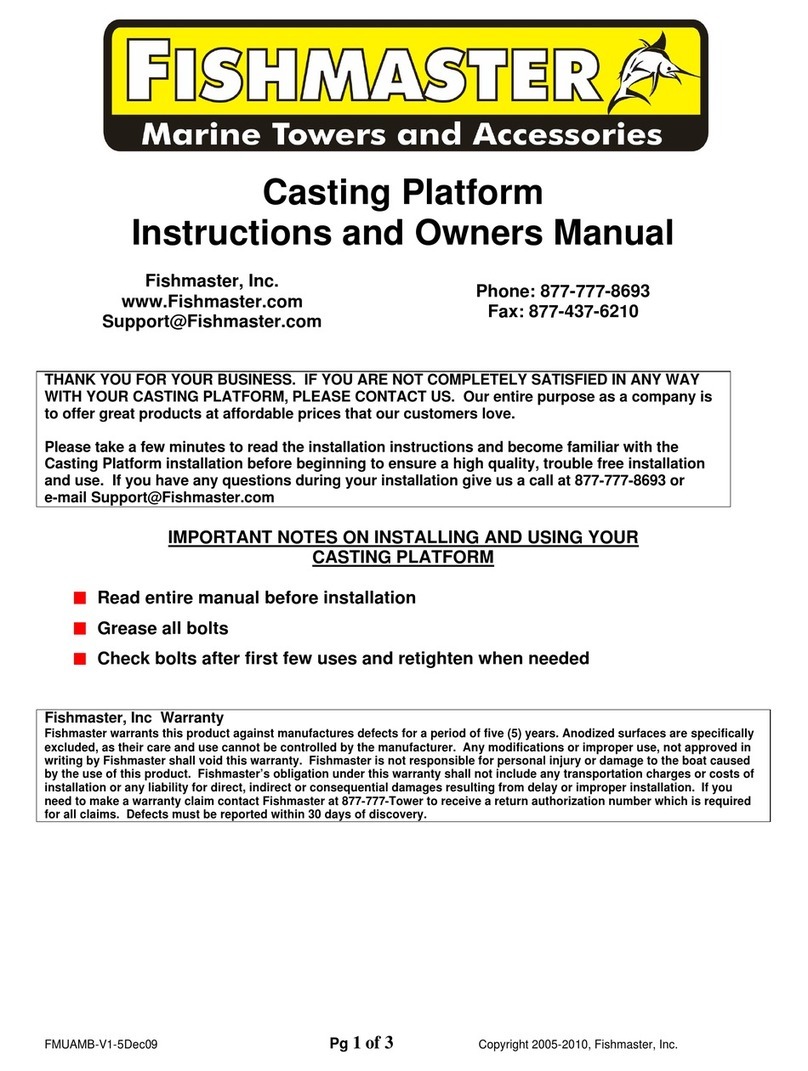
Fishmaster
Fishmaster Casting Platform Instructions and owner's manual


